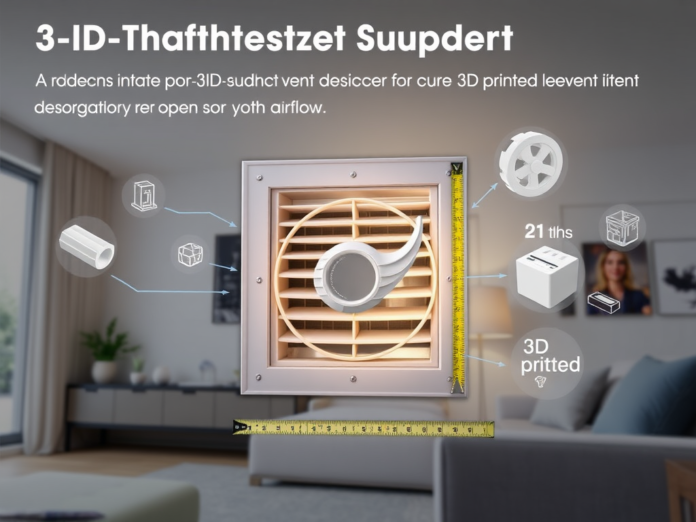Proper airflow inside your home or office is essential for comfort and efficiency. Sometimes, furniture placement, heavy objects, or the design of vent covers can block airflow, reducing the effectiveness of your heating or cooling system. One simple and effective solution is to use a 3D print to keep the vent open. In this article, we’ll explain how you can create 3d-printed devices to protect your vents, improve air circulation, and customise the design to match your space.

Why Keep Vents Open?
Before diving into 3D printing solutions, it’s essential to understand why keeping vents open matters:
- Energy Efficiency: Blocked vents force HVAC systems to work harder, increasing energy bills.
- Comfort: Rooms with poor airflow can become too hot or too cold.
- System Longevity: Proper airflow reduces wear and tear on heating and cooling units.
- Air Quality: Consistent circulation helps maintain healthier indoor air.
In short, blocked vents lead to higher costs, less comfort, and more maintenance issues — all of which can be easily avoided with the right solutions.
How 3D Printing Can Help Keep Vents Open
3D printing offers a customisable and cost-effective way to create vent supports that:
- Prevent vents from closing accidentally.
- Support heavy furniture resting near vents.
- Allow full airflow without modification to the original vent system.
Since every vent and room layout is unique, being able to design and print a custom support piece is a significant advantage.
You can create:
- Small risers to hold the vent open.
- Protective frames around the vent.
- Custom grates that direct airflow more efficiently.
With a 3D printer, your options are almost unlimited.
How to 3D Print a Vent Support
Creating a simple device to keep your vent open can be an easy DIY project. Here’s a basic process:
- Measure Your Vent
Accurately measure:
- The width and height of the vent.
- Distance from the vent to the floor or furniture.
- Space needed for unobstructed airflow.
- Choose or Design a Model
Search online 3D model libraries for “vent supports” or “airflow spacers.”
Use free 3D modelling software like Tinkercad if you want to design a custom solution. - Select a Material
Good filament choices include:
- PLA: Easy to print, suitable for indoor use.
- PETG: Stronger and slightly flexible for more durable supports.
- Print the Support
Use a layer height of 0.2mm for strength and decent print speed.
Print with around 30%-50% infill to ensure the support is sturdy. - Install and Test
Place the support around or near the vent.
Ensure it doesn’t obstruct airflow and holds up to any weight from nearby furniture if needed.
Tips for Designing Better Vent Supports
Maximise effectiveness with these simple tips:
- Keep Openings Clear: Make sure your design doesn’t block the actual vent openings.
- Use Rounded Edges: Rounded corners make the supports stronger and safer.
- Colour Match: Print using filament that matches your floor or furniture for a cleaner look.
- Add Weight or Feet: Add small pads or heavier bases to keep supports stable if needed.
A few thoughtful design tweaks can make a big difference in both appearance and functionality.
READ MORE – Expandability Robot Labelled: Understanding Modular Robotics
FAQs:
Q1: What filament is best for printing vent supports?
PLA is great for most indoor uses, but PETG is recommended if you need something stronger or slightly flexible.
Q2: Can I find ready-made designs online?
Yes, sites like Thingiverse and Printables often have free models you can download and print.
Q3: Will a 3d-printed support damage my floors or vents?
Not if properly designed. Adding soft pads or printing with smooth bases helps avoid any scratching.
Q4: How much filament does a vent support use?
Most simple vent supports use around 20–50 grams of filament, depending on size and density.
Q5: Can I adjust airflow direction with a 3d printed piece?
Absolutely! You can design custom louvres or airflow directors to help control the direction of heated or cooled air.
Conclusion
Using a 3d print to keep your vent open is an innovative, low-cost way to improve airflow, boost home comfort, and protect your HVAC system from unnecessary strain. With just a few simple measurements, a 3d printer, and a little creativity, you can design supports that match your space perfectly and solve airflow problems quickly. Whether you need to hold a vent open under heavy furniture or want to fine-tune air distribution, 3d printing gives you the tools to create the ideal solution for your home or office.




